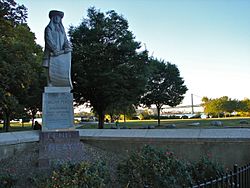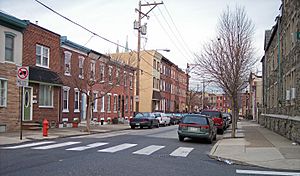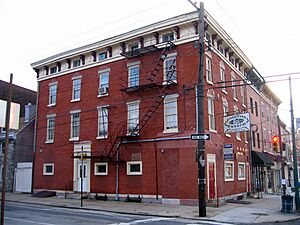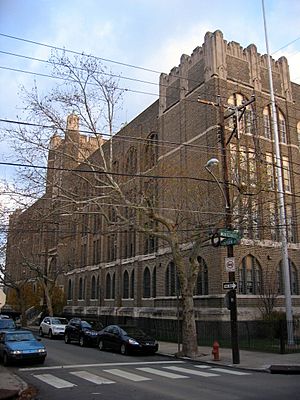Fishtown, Philadelphia facts for kids
Quick facts for kids
Fishtown
|
|
|---|---|

Penn Treaty Park in Fishtown
|
|
| Country | |
| State | Pennsylvania |
| County | Philadelphia County |
| City | Philadelphia |
| Area code(s) | 215, 267 and 445 |
Fishtown is a lively neighborhood in Philadelphia, Pennsylvania, located northeast of the city center. It's known for its unique history and changing community. The area gets its name because many of its first residents were fishermen. They had special rights to fish in the Delaware River for a long time.
Even though its exact boundaries can be a bit tricky to define, Fishtown is generally found in the triangle formed by the Delaware River, Front Street, and York Street. The Market–Frankford Line train helps people get around the neighborhood. For many years, Fishtown was home to many working-class families, especially those with Irish American backgrounds. More recently, many young professionals have moved in, bringing new businesses and changes to the area.
Contents
History of Fishtown
Early Settlers and Kensington's Beginnings
Long ago, the land where Fishtown now stands was home to the Turtle Clan of the Lenape Native American tribe. The first Europeans to settle here were six Swedish farming families. Later, British landowners and shipbuilders, and German fishermen also moved to the area.
Fishtown was originally a small part of a larger town called Old Kensington. It was very close to the Delaware River. Today, Penn Treaty Park is located where the Fairman Mansion, an important early building, once stood.
Captain Anthony Palmer, an Englishman, founded Kensington. He bought the Fairman Estate in 1729 and created the town, selling plots of land to fishermen and shipbuilders. Anthony Palmer later became an important leader in Pennsylvania. He was even the acting Governor of Pennsylvania from 1747 to 1748. The Kensington Burial Grounds, also known as Palmer Cemetery, was started around 1732 on land given by the Palmer family. It is still used as a burial ground today.
Growing Community and Changes
Over time, more people moved to Fishtown. First, there was another wave of German immigrants. Later, in the late 1800s, many Polish and Irish Catholic immigrants arrived. The community built two Roman Catholic churches: St. Laurentius, built by Polish immigrants, and Holy Name of Jesus, built mostly by Irish immigrants. Holy Name of Jesus still serves the community today. St. Laurentius was sold and later torn down starting in 2022.
For centuries, Fishtown was a neighborhood where many people had jobs in factories and industries. Even when many jobs left the area, the community remained strong. In the mid-1900s, most residents were white, with roots in Irish, German, and Polish families. By 2024, the neighborhood was still mostly white, but the percentage had decreased.
Since 2005, Fishtown has seen many changes. Housing prices have gone up, and new art galleries, entertainment spots, and restaurants have opened. Many artists and professionals have moved into the area, joining the police officers, firefighters, nurses, and skilled tradespeople who have long lived there. By 2023, Fishtown had become one of the higher-income neighborhoods in Philadelphia.
The state of Pennsylvania chose Fishtown as the location for the Rivers Casino Philadelphia gaming complex. This decision caused some debate in the neighborhood. Some people believed it would bring jobs and help the economy, while others worried about negative impacts on the community. However, an agreement was made between the casino and local community groups to provide money for neighborhood projects.
Important Landmarks
Fishtown has several buildings that are recognized for their historical importance. The George Chandler School, Green Tree Tavern, and Penn Treaty Junior High School are all listed on the National Register of Historic Places.
Other buildings are protected by the City of Philadelphia because of their historical value. These include:
- Bradlee & Co.'s Empire Chain Works, built between 1905 and 1910.
- The Edward Corner Warehouse, built in 1921.
- The Frederick J. Rapp House, built around 1786.
- The Fifth Dutch Reformed Church, built around 1863.
- The Jacob Souder Frame Dwelling, built around 1810.
- The Joseph Paxson Frame Store & Dwelling, built around 1827.
- The Morse Elevator Company buildings at 1101-03, 1105-09, and 1111-17 Frankford Avenue.
- The Otis Elevator Company's Boiler & Engine House, built in 1904.
- The Penn Asylum for Indigent Widows & Single Women (also known as The Penn Home), built around 1769.
- The 10th District Patrol House & Stable, built between 1891 and 1892.
Education
The School District of Philadelphia manages the public schools in Fishtown. Alexander Adaire School is the elementary school for the community. Penn Treaty School, which teaches grades 6 through 12, is also located in Fishtown. St. Laurentius School is a private school in the neighborhood.
Fishtown in Pop Culture
Fishtown has been featured in books and TV shows:
- In the book Coming Apart: The State of White America, 1960–2010 (2012), a political scientist named Charles Murray used the idea of Fishtown to represent a certain type of working-class community.
- The comic book Fishtown (2007–8), by Kevin Colden, tells a story based on a real event that happened in the neighborhood.
- The 2020 AMC television series Dispatches from Elsewhere, created by and starring Jason Segel, was partly filmed in Fishtown and features the neighborhood in several episodes.
- Season 5 of Netflix's reboot series Queer Eye was filmed in Philadelphia, and Fishtown was a main filming location for one of its episodes.
Images for kids
-
Penn Treaty Park in Fishtown







